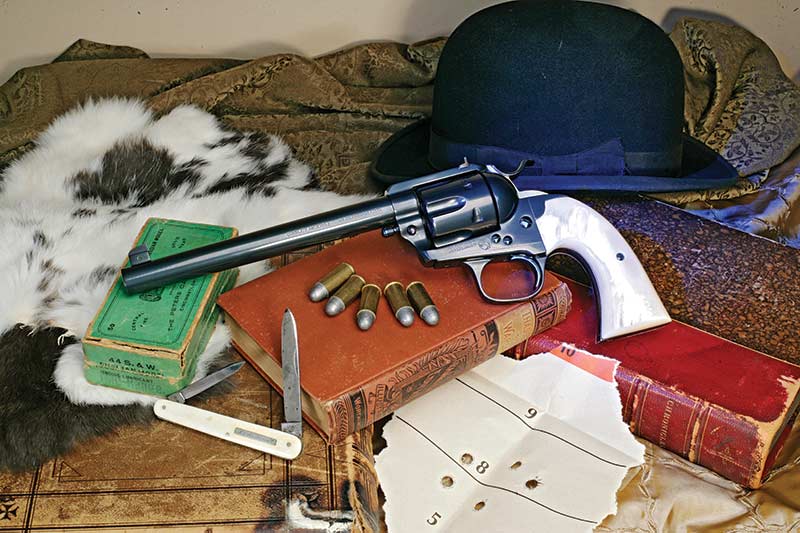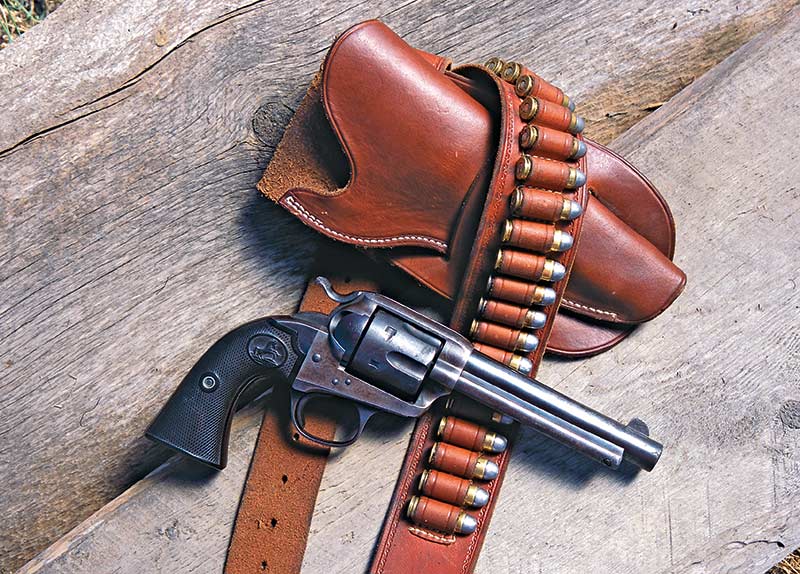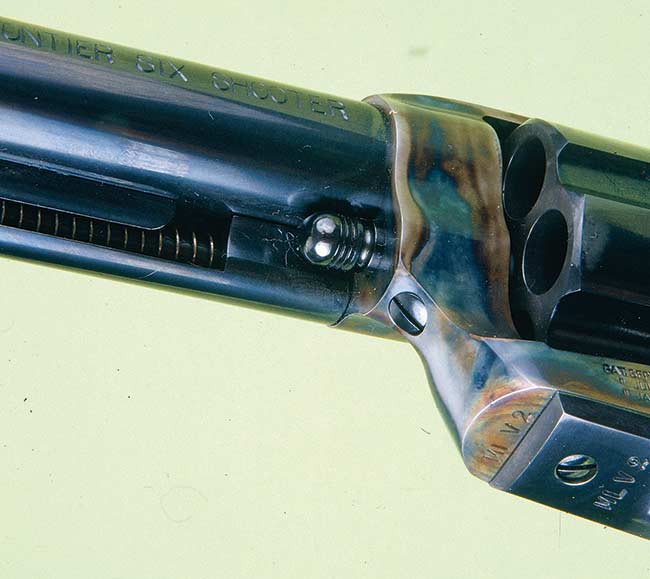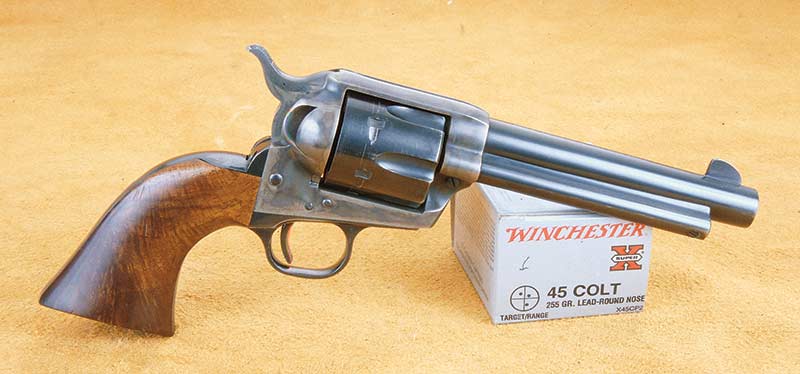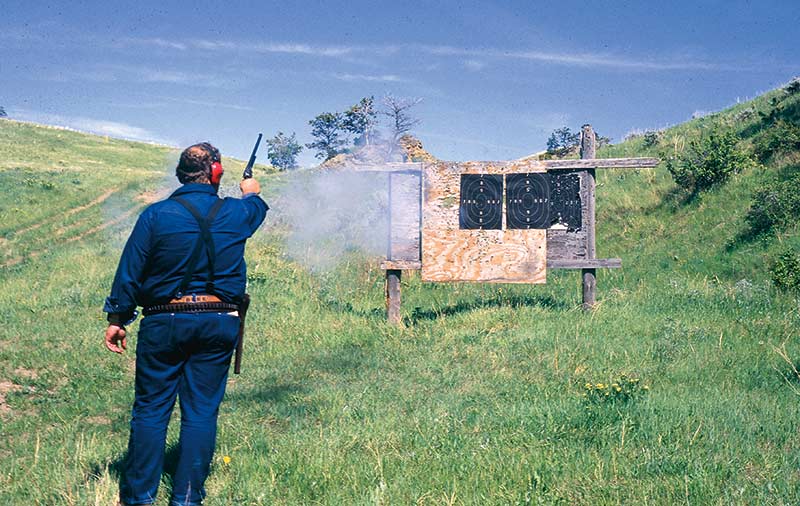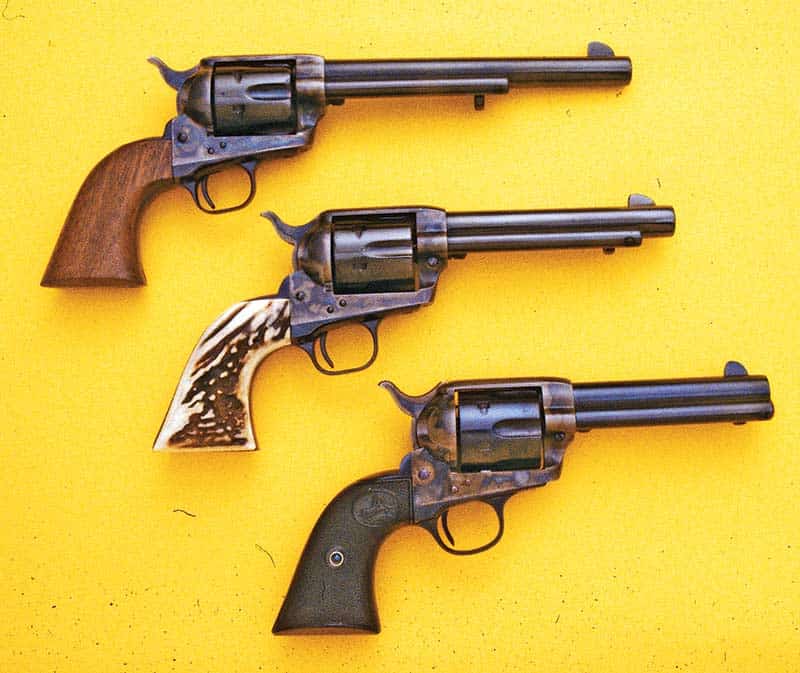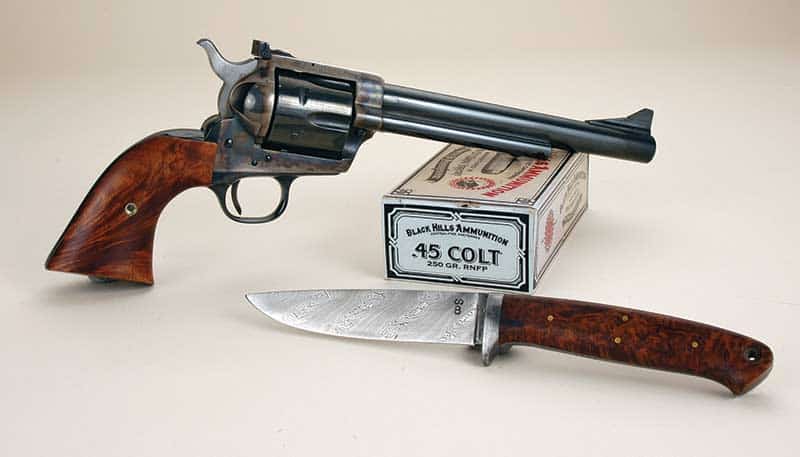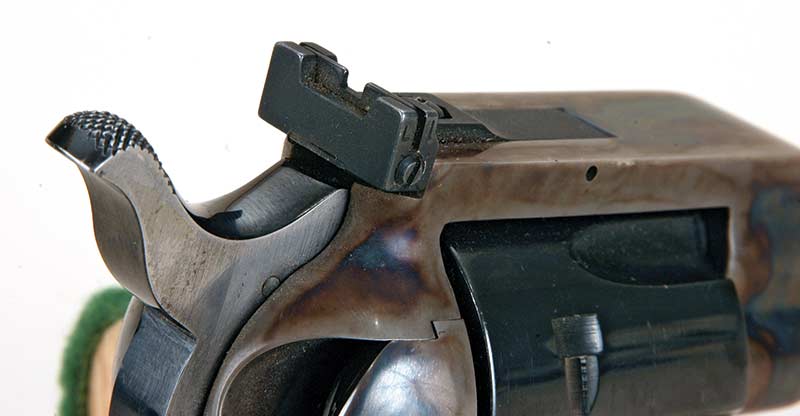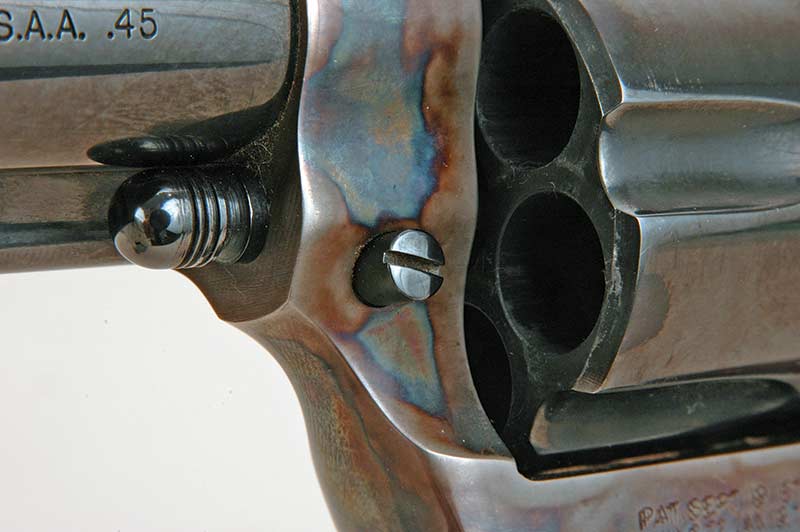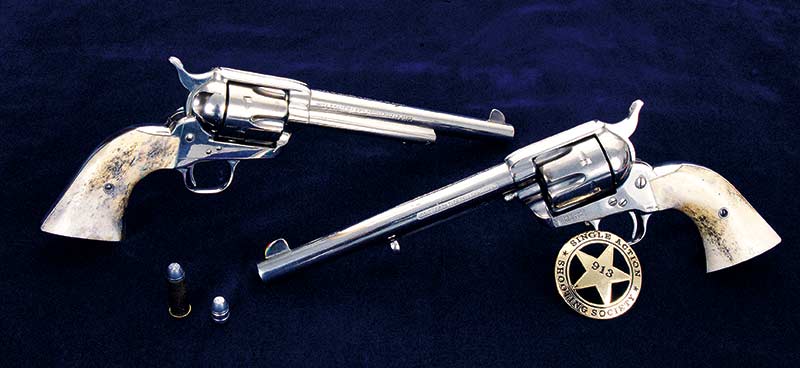The Other Colt Single Actions
Such A Popular Revolver Was
Bound To Have Many Variations
Arguably the most famous handgun in history is the Colt Single Action Army revolver. Others might vote for the P-08 Luger, or Colt 1911, or even the Walther PPK, but let’s face it, Hollywood made it possible for the big Colt Peacemaker to be seen everywhere movies have been shown or television is received. And, that’s nigh on everywhere!
If people who get their firearms expertise by watching movies and television were asked to describe a typical Colt Single Action revolver it would probably be as follows. A barrel length “about” to the end of the ejector rod housing, a nicely curved grip frame, fixed sights, and with finishes as either full nickelplating or with frame color case hardened with the rest of the revolver blue. A few older TV watchers might also remember Marshall Matt Dillon and Paladin carried Colts with significantly longer barrels.
All the above would be right on the mark. The standard Colt Single Action Army revolver during all three manufacturing generations has had 43⁄4″-, 51⁄2″-, and 71⁄2″-barrel lengths. The sighting arrangements consist of nothing more than a blade front sight with a groove down the frame’s top strap for a rear sight. Standard finishes have also been blue/case color and full nickel-plating. And lastly if there ever has been a handgun with an “everyman” grip it’s certainly that beautifully curved one of the standard Colt Single Action Army revolver. Such is the quintessential Peacemaker.
Variety
Be that as it may, the Colt SAA has been made with an amazing variety of other features, not to mention many sub-variations with specific names such as Bisley, Sheriff’s Model, Buntline and New Frontier. Even within the standard Colt SAA version there are two broad categories of frame types. First there was the so-called “black-powder frame” — which it is not — and the “smokeless powder frame” — again, which, it is not. Details will follow.
And here’s an astonishing point. The best Peacemakers being made today are not Colts. Nor does Colt offer Peacemakers in any of the sub-variations they themselves made famous. They don’t even make the two basic frame styles mentioned in the previous paragraph. Is that dumb or what? Well Colt has been so dumb now for a couple of decades they have dug themselves a huge hole and are right on the edge of falling into it. Never fear. Someone else does make an immense variety of SAA variations and to a quality level Colt can only dream about. And we are not talking foreign imports, but 100 percent Made-in-the-US sixguns. Again details will follow.
First let’s look at the two basic frames used to build Colt Single Action Army revolvers during its 133 years of existence. The first frame style used a screw angling in from the front to secure the cylinder’s base pin. Because this frame style was standard from 1873 until 1892 collectors dubbed it the “black-powder frame.” Starting about in 1892, but not becoming standard until 1898, Colt introduced a frame wherein the cylinder base pin was secured by a transverse spring-loaded latch. This is what is called a “smokeless-powder frame,” but since Colt did not warranty the SAA for smokeless powder until 1900, obviously the name is a misnomer. Although the frame style with transverse latch has been standard for over 100 years, it should also be mentioned Colt made the so-called “black-powder frame” available again in commemorative form in the 1970s, and on special order from the Colt Custom Shop in the 1980s. They’re not made now.
Personally speaking, I prefer the older style frame because I’ve seen many of the transverse latches loosen and fall off the revolver, but never have experienced the angled screw coming all the way out and being lost. That’s just my opinion.
The Bisley
The most distinctive appearing version of the Colt SAA, indeed one of the most distinctive appearing handguns ever made, is the Bisley. It was developed in 1894 specifically for bull’s-eye target shooting, and a little known fact is that the very first Bisley Colts were built with flattop frames, target sights, and were in the British .455 caliber. They were sent to England to be used in matches at Bisley Common. (They sure wouldn’t be welcome in England now!) By 1896 Colt decided to add that oddly angled grip frame to their standard Peacemakers. It might also interest readers to know that the grip frames between standard SAAs and Bisleys are not interchangeable. The main frame of a Bisley revolver is slightly deeper than a Peacemaker’s frame. I don’t like the Bisley grip, and again that’s speaking personally. It might fit some limp-wristed types but not me.
Regardless it sold very well when in the Colt catalog. Until 1912 when it was dropped, more than 44,000 fixed-sight Bisleys were made along with about 1,000 flattop versions. More were made as .32-20s than any other caliber, with .38- 40 and .45 Colt in second and third places.
Sheriff And Storekeeper
For me, one of the more practical subvariants of the Colt SAA is the Sheriff’s Model. This revolver has only a 3″ barrel with no provision for an ejector rod housing. How can that be practical? After all, getting the empty cases out of the chamber requires a small rod or punch. Right, but I like the Sheriff’s Model because it can easily fit in a jeans pocket or even hip pocket. Now, don’t get excited. I don’t carry one for self-defense — it’s not that practical. Instead, in warm months on my place here in Montana I often stick one in my pocket with five shot loads in the cylinder and occasionally use it to blast rattlesnakes. I don’t need a quick reload there. Indeed, I don’t even carry extra cartridges. My Colt Sheriff’s Model with dual .44 Special/.44-40 cylinders is about the only handgun I’ve ever actually used for nonsporting or nonrecreational purposes. I don’t consider shooting rattlers around my house or outbuildings as sport!
There’s also a sub-variation of this subvariation called the Storekeeper’s Model. It only differs from a Sheriff’s Model in that it has a 4″ barrel. Back in the days, the real Wild West Colt would make up a “Sheriff’s Model or Storekeeper’s Model” (They weren’t named such then.) in just about any caliber offered, but in modern times they have only been made as .45 Colts or the dual cylinder .44, like I have.
Buntline
The least practical of all SAA subvariations (in my humble opinion) is the Buntline. A 12″ barrel on a handgun is about as useful as a 3″ jack handle. The legend behind the whole Buntline story is a dime novelist named Ned Buntline had some Peacemaker’s made up with 16″ barrels back in the 1870s and gave them to noted Western lawmen such as Wyatt Earp and Bat Masterson.
There’s some doubt among historians about whether that actually happened, but no worry. The popular 1950s TV show about Earp portrayed him carrying such, so that’s that. In 1957 Colt started offering Buntlines with 12″ barrels because the Feds would have heartburn with 16″ ones. They were sold in both Second and Third Generations of SAA production. Most were made as .45 Colts, but some .44 Specials with extra .44-40 cylinders do exist. They were simply regular Peacemakers fitted with extra-long barrels. I owned a Buntline .45 once and no less practical handgun might exist. I even once missed a standing coyote at no more than 25 or 30 yards with mine.
Evidently others agree with me about Buntlines because through most of their history they have sold for less than a comparable SAA with shorter barrel. I know many single-action shooters who bought them cheap and then had shorter barrels installed.
New Frontier
As far as practical shooting is concerned one of the best Colt single actions ever made is also usually priced less than standard Peacemakers. That would be the New Frontier, which is nothing more than a modernized Flattop Target. Colt introduced the New Frontier in 1961, and it differed from a standard model only in the size and shape of the frame’s topstrap, the hammer, and the ramp front sight on the barrel. Things like grip frames, cylinders, ejector rod housings, and all internals were identical to regular SAAs. That is except for the bluing — it was called Colt’s Royal Blue.
Because of its high profile sights the New Frontier is actually easy to hit something with. That certainly didn’t help its sales. Serial numbers started at 3000NF and by 1974 when Colt stopped making it the first time serial numbers had only reached 7288FN. In 1978 Colt started making New Frontiers again and started their serial numbers over, but my research material doesn’t indicate how many were made. It wasn’t many. They stopped making them altogether in the 1983/1984 time frame. In their First Generation, New Frontiers were made in .45 Colt, .44 Special, .357 Magnum and .38 Special calibers with barrel lengths of 43⁄4″, 51⁄2″, and 71⁄2″. For the Second Generation run, drop .38 Special and add .44-40 to the caliber assortment and include a few 12″ Buntline New Frontiers.
Frontier Six Shooter
There’s just one other minor sub-variation of the Colt Single Action Army revolver I want to mention because its my all-time favorite — in fact my all-time favorite handgun period. That’s the Frontier Six Shooter. The name certainly sounds like something a dime novelist would coin, but Colt did it themselves back about 1877. They actually inscribed the side of the barrel that way. A Colt Frontier Six Shooter is absolutely nothing different from a standard Peacemaker except its chambered in .44 WCF (.44-40) caliber. When Colt returned the .44-40 caliber to the SAA list of chamberings in 1982 they labeled some just “.44-40,” and others “Colt Frontier Six Shooter” with no other caliber marking.
Back in the 1970s Colt decided to commemorate 100 years of the SAA with a Peacemaker Centennial. In 1975, the firm made 2,002 Frontier Six Shooters precisely as they had been made in the 1870/1880 time frame with the angled screw through front of frame to secure cylinder base-pin (black-powder frame), proper markings for the era, proper bevels on the cylinder flutes, cone-shaped firing pin, etc. I bought two of those and had them fitted with bison bone grips. I consider them the best Colt Single Action revolvers ever made. From my entire collection they would be the last to go. When I shoot single actions for my own personal pleasure those two are among the most fired.
So, besides the American legend of the Colt Peacemaker, there are sub-legends called Bisley, Storekeeper’s Model, Sheriff’s Model, Buntline, New Frontier, and Frontier Six Shooter. They’re all the same — just different.
United States Firearms Single Actions
From Colt you can’t buy any of the historical sub-variations of SAA revolvers mentioned in this article. All they sell is the standard version with “smokeless powder frame” and 43⁄4″, 51⁄2″, and 71⁄2″ barrel. You also can’t get a new Colt SAA chambered for some of that company’s own historical cartridges such as .41 Colt or .44 Colt, or even the .22LR, for which some original Peacemakers were actually chambered.
But, you can get extremely fine-quality, 100-percent American-made single-action revolver crafted down to the detail exactly as Colt produced them throughout their history. They even come from the same city — Hartford, Connecticut. They are being made in a brand new factory there, and I’m here to tell you they are exceptional revolvers. The company is called United States Firearms Mfg., and a decade ago they began by importing parts from Italy and finishing them here. They don’t now. A few years back they completed construction of their own factory, and their officials tell me they don’t even stock parts from abroad anymore.
Sometimes my enthusiasm is a drain on my pocketbook. At SHOT Show 2004, I spent quite some time in the USFA booth, and ended up ordering a Frontier Six Shooter from them. I told them to make it with 71⁄2″ barrel just as one would have been built circa 1880. When it came it blew my socks off. The bluing and color case hardening was the best I’ve seen on an American-made revolver in decades. Furthermore, they built my .44-40 correct right down to the details such as extra fine front and rear sights. It also shot wonderfully — machine rest groups of 11⁄2″ for 12 shots at 25 yards is wonderful in my book. Also it hit right to point-of-aim right out of the box, and the action needed no tuning or smoothing whatsoever.
I was on a roll. Next I ordered engraved Frontier Six Shooters for both my wife Yvonne and myself. Hers has the 51⁄2″ barrel she prefers and mine carries the 43⁄4″. Both are fine examples of the revolver maker’s art. They shoot just as good as the long-barreled one.
I still wasn’t done. At SHOT Show 2005 while visiting the USFA booth I noticed a grungy looking SAA and asked about it. That “grungy” .45 happed to be their Custer Battlefield revolver — identical even to the inspector’s marks as the Single Action Army revolvers carried by 7th Cavalrymen in 1876. I ordered one on the spot and was even lucky enough to get serial number 1876!
And I’m still not done. As I write this I’m waiting impatiently for the UPS truck to arrive, carrying my USFA .45 with 43⁄4″ barrel.
USFA made up single-action revolvers in the following configurations: Bisley, Storekeepers & Sheriffs Models, Flattop Target, smokeless powder or blackpowder frame. They will chamber them for the popular calibers such as .45 Colt, .44-40, .38-40, .38 Special, .357 Magnum, and .32-20. They also made them in .22 LR, .41 Colt, .44 Colt, and others you may not have even heard of.
And lest you think this article is nothing but an advertisement for them because of all the free single actions I’ve been given, think again. In less than two years I bought five USFA revolvers. That’s the best recommendation I can give.

Get More Revolver Content Every Week!
Sign up for the Wheelgun Wednesday newsletter here:
